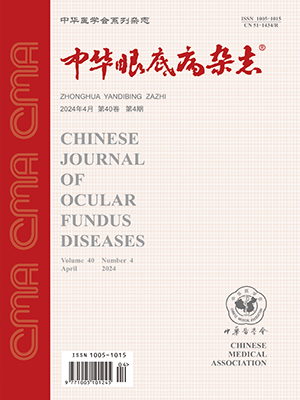Objective To investigate the inhibitory effects of 15-lipoxygenase-1 (15-LOX-1) gene transfer on oxygen-induced retinal neovascularization in mice. Methods Ninety-six 7-day-old C57BL/6J mice were randomly divided into normal control group, oxygeninduced retinopathy (OIR) model group, gene treated group and empty vector group. The mice with their mothers were kept in (75 plusmn;2) % 02 environment for 5 days and then returned to normoxia for 5 days to establish the OIR model. At postnatal day 12, the gene treated group received intravitreous injection of recombinant adenovirus (Ad) vector containing both enhanced green fluorescent protein (EGFP) and mouse 15-LOX-1 genes (Ad-15-LOX-1-EGFP) at 1 l, while the empty vector group received the same volume of recombinant Ad vector containing EGFP (Ad-EGFP). The expression of EGFP was observed on flat-mounted retina by fluorescence microscopy 2 days after intravitreous injection of Ad-15-LOX-1-EGFP. At postnatal day 17, the efficacy of 15-LOX-1 gene transfer on retinal tissue was detected by immunofluorescence staining, real-time polymerase chain reaction and Western blot. The changes of retinal vessels, relative retinal non-perfusion and neovascularization areas were evaluated by fluorescein isothiocyanate-dextran fluorescein angiography on flatmounted retina. The number of endothelium cell nuclei breaking through the inner limiting membrane (ILM) was counted on hematoxylin and eosin-stained retinal section. Results Two days after intravitreous injection of Ad-15-LOX-1-EGFP, the expression of EGFP had been seen by fluorescence microscopy on Flat-mounted retina. Immunofluorescence staining of retinal section revealed that 15-LOX-1 expression was primarily in the outer plexiform layer, inner nuclear layer and ganglion cell layer of retina. The 15-LOX-1 protein and mRNA expression levels were higher in gene treated group than those in OIR model group and empty vector group (tprotein=22.74 and 24.13 respectively.tmRNA=12.51 and 13.40 respectively; P<0.01). The relative retinal non-perfusion and neovascularization areas were significantly smaller in gene treated group than those in OIR model group and empty vector group (tnon-perfusion=16.22 and 14.31 respectively.tneovascularization=9.97 and 9.07 respectively; P<0.01), and the number of endothelium cell nuclei breaking through the ILM in gene treated group was obviously lower than the other two groups (t=14.25 and 11.62 respectively,P<0.01). Conclusion 15-LOX-1 gene transfer can decrease the oxygen-induced retinal non-perfusion areas and inhibit the retinal neovascularization in mice.
Citation: 黎智,贺涛,杜珂,陈长征,邢怡桥. Inhibitory effects of 15-lipoxygenase-1 gene transfer on oxygen-induced retinal neovascularization in mice. Chinese Journal of Ocular Fundus Diseases, 2013, 29(4): 406-410. doi: Copy




